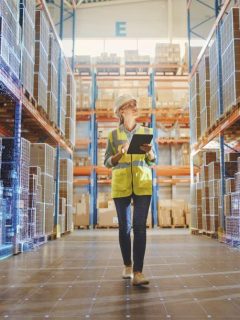Are you looking for a more sustainable logistics strategy? There are many factors to consider. Among other things, you need to think about your company’s growth, the environmental challenges associated with your supply chain and the stakeholders involved. It’s important to remember that sustainability is about more than the environment, it’s also about economic and social issues.
To help you on your way, here are 7 tips for more sustainable logistics in your organisation.
#1: Implement a responsible sourcing policy
The aim of this is to develop a supply chain that contributes to sustainable development. One measure to consider is choosing locally sourced goods or local suppliers. You should also survey your suppliers to find out what environmental commitments they make and how they work with sustainability.
If your company is large enough to be covered by the Transparency Act, you must also conduct a due diligence assessment of whether there is a risk that your own business and/or supply chain contributes to human rights violations or poor labour conditions.
#2: Review your packaging use
In your logistics processes, packaging is undoubtedly one of the easiest areas to implement measures to improve your company’s environmental responsibility.
To get started, start by reducing empty space in your parcels. Shipping air is not environmentally friendly, it allows for fewer packages to fit on each lorry and leads to unnecessary use of raw materials. And last but not least, it leads to higher shipping costs if you’re billed by volume weight.
So make sure you choose packaging that is best suited to the size and weight of your goods.
Also remember to choose environmentally responsible packaging. This is crucial for sustainable logistics. Environmentally responsible packaging use is important to give your customers a good customer experience and help you stay competitive.
We recommend you take a look at RAJA’s 5 packaging principles. Here you can find inspiration for finding packaging that is better for the environment.
The 5 packaging principles are to:
- Reduce: You can reduce the consumption of packaging by keeping the weight and volume of packaging to the minimum necessary to provide good product protection. For example, you can use packaging with integrated protection, such as padded paper envelopes.
- Recycle: Whenever possible, RAJA offers packaging designed to be easily reused. Examples are returnable packaging, reusable plastic pallets or stackable plastic boxes instead of cardboard boxes for storage.
- Replace: To protect the environment, we need to replace packaging that is non-recyclable or has a high environmental impact with environmentally responsible alternatives. There are many innovative new products to choose from, such as paper bubble wrap or something as simple as paper packing tape.
- Innovate: Using bio-based packaging made from renewable natural materials helps to reduce our impact on the environment.
- Recycle: To move towards a circular economy that minimises waste and makes the most of resources, we need to develop our recycling to give packaging a second life. Here, RAJA can offer a wide range of packaging made from recycled materials, such as e-commerce bags made from recycled plastic.
3: Introduce better waste sorting in your warehouse
As a logistics manager, your goal is also to ensure that your warehouse employees have good working practices that respect the environment. An important measure here is to be aware of waste sorting.
Some simple measures:
- Start by assessing how you currently sort waste to find out what you need to do to improve.
- Install bins and containers that make sorting easier. Different coloured bins and bags placed in strategic locations will help you improve this management.
- Choose the right collection service providers for your different waste streams.
- Provide good waste sorting training and remember to reward the efforts of your employees.
#4: Make your logistics processes as paperless as possible
Digitalising your processes will reduce the use of paper and therefore contribute to greener logistics. It may seem like a small measure, but it can really make a difference!
Some examples:
Implement a Warehouse Management System (WMS) if you haven’t already done so. Among many other benefits, it means you don’t have to print out picking slips.
Send less paper mail to suppliers, customers and prospects and encourage communication via email.
Remember to choose green IT solutions if possible – these are digital solutions that also take the environment into account.
#5: Introduce more environmentally responsible shipping
In your logistics strategy, shipping your goods is the most polluting element. That’s why it’s crucial to review your delivery strategy and consider how it can become more sustainable.
Start by reviewing your delivery times. Express deliveries often require lorries to run almost empty, which is highly negative from an environmental perspective. Therefore, give your customers the option to choose a slightly longer delivery time for the sake of the environment. However, be careful not to damage the customer experience in the process. Leave it up to the customer to choose between different delivery times with different environmental impacts – and different prices.
Then set up delivery methods that are as fossil-free as possible. In particular, think about finding environmentally friendly modes of transport for delivery to the customer’s door. In urban areas, perhaps you can switch to delivery by bicycle courier?
Also, make sure you use carriers that are environmentally certified and operate in the most environmentally responsible way possible.
Do you have your own car fleet? Consider switching to electric cars if possible.
#6: Ensure you practice people-centred management
Sustainable logistics is also about looking after the people who are part of the logistics processes. Good management is an important measure to retain employees in the warehouse and increase their productivity.
Some actions you should take:
Have an approachable management style with an open-door policy to discuss any challenges warehouse employees face.
Make your warehouse teams as autonomous as possible to maximise the value of their work.
Consider employee expectations in terms of career development through an ongoing competency development plan.
Remember HSE! Always prioritise the safety and wellbeing of your logistics team. For example, look at ways to minimise the risk of musculoskeletal disorders by using appropriate machinery and training. To do this, consider equipping yourself with good chairs, a customised work table or packing station that can be adapted to the needs of your employees, as well as an anti-fatigue mat that takes ergonomics into account.
#7: Reorganise your warehouse in a more environmentally friendly way
The final tip to aim for more sustainable logistics is to make your entire warehouse as environmentally responsible as possible.
Start by limiting the number of journeys logistics staff make around the warehouse. After all, movement means switching on lights and using handling equipment more intensively. So reviewing your warehouse management strategy can help limit these physical flows in the warehouse. Plus, by better managing these movements, you can improve the productivity of order pickers in the picking phase, thereby increasing their capacity.
You should also think about managing energy consumption more efficiently. Some measures to consider:
- Switch to LED lights in your warehouse
- Implement energy efficiency measures in the warehouse, such as night-time temperature reduction or motion sensors that control lighting
- Limit energy loss, e.g. by switching off machines that don’t need to be on all the time, or by reviewing the insulation of your doors and windows.
These tips will help you on your way to more sustainable logistics management. If you implement these measures, you’ll achieve a warehouse that meets the needs of your business, takes into account the people who work there and, not least, the environment.














